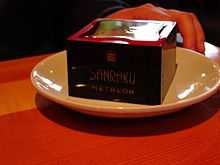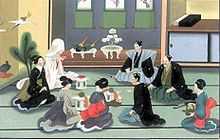Sake set

A sake set is a generic term for the flask and cups used to serve sake, the traditional Japanese alcoholic beverage made from rice. Sake sets are commonly ceramic, but may be glass or lacquered plastic. The flask and cups may be sold individually or as a set.
Server

The server of a sake set is a flask called a tokkuri (ja:徳利). A tokkuri is generally bulbous with a narrow neck, but may have a variety of other shapes, including that of a spouted serving bowl (katakuchi). Traditionally, heated sake is often warmed by placing the sake-filled tokkuri in a pan of hot water, and thus the narrowed neck would prevent the heat from escaping. In more authentic places such as oden bars and ryōtei in Japan, sake is sometimes warmed and served in metal containers known as chirori (ja:ちろり, kanji:銚釐)[1][2][3][4] or tanpo (ja:たんぽ, kanji:湯婆).[5] Recently, glass chirori are also used to chill sake.[6]
Drinking cups

Formerly, sake was sold by volume in a wooden box measuring cup, known as a masu[7] which has a volume of 180 ml (1 gou, 6 fl oz) and was also used to drink. In the past, the wooden box was said to complement the traditionally brewed sake, as it is brewed in a wooden cask (ja:樽), but in modern times, the masu is shunned by sake purists because the wood affects the flavor of the sake. Furthermore, tradition requires the masu be filled to the rim as a sign of prosperity. Masu are now commonly made of lacquerware or even of ABS plastic. As the traditional sake-serving cup and a symbol of prosperity due to sharing the same pronunciation as the Japanese word for increase/proliferate (wiktionary:増す), the masu is still used in modern times for the purpose of ceremony or to show generosity. In some Japanese restaurants, the server may put a glass inside the masu (or put the masu inside a saucer) and pour until the sake overflows and spills into the secondary container to symbolize this wealth.

Nowadays, the sake is typically served in ceramic cups. The cups used for drinking sake are generally small cylindrical vessels called ochoko or choko (ja:猪口, o- is an honorific prefix in Japanese used such as osake and omakase), but may also include flatter shapes such as wide-mouthed bowls. Sakazuki are ceremonial cups used most commonly at weddings and other special occasions such as tea ceremonies, but larger versions of sakazuki also exist.
While not a traditional serving utensil, a shot glass is also used. In the United States, it is used as a substitute for ochoko, while in Japan it is used in conjunction with masu. Sake stemware is also used, which is essentially a glass sake cup elevated above a wide base. Sake stemware, as well as glass tokkuri, are now commonly used to serve chilled sake.
References
- ↑ James Curtis Hepburn "Chirori", A Japanese and English dictionary: with an English and Japanese index, American Presbyterian Mission Press (Shanghai), 1867, p. 41.
- ↑ (Japanese) "銚釐", kotobank/Asahi Shimbun, accessdate=2010-12-22.
- ↑ (Japanese) "お燗グッズ 本格派錫製ちろり", Japan Prestige Sake Association, accessdate=2010-12-22.
- ↑ Sepp Linhart "Some Thoughts on the Ken Game in Japan: From the Viewpoint of Comparative Civilization Studies", Senri Ethnological Studies, 40 (1995), p. 101-124.
- ↑ (Japanese) "湯婆", kotobank/Asahi Shimbun, accessdate=2010-12-22.
- ↑ (Japanese) "ちろり", Dewazakura Sake Brewery Corporation, accessdate=2010-12-22.
- ↑ (Japanese) "枡酒", Yahoo! Japan Dictionary/日本国語大辞典, accessdate=2010-12-22.
External links
| Wikimedia Commons has media related to Sake sets. |
- Sake Flask Shapes Guide
- Tokkuri- Sake Flask Shapes
- Sake traditions
- Learn About Sake Set
- Yoshio Tsuchiya, Masaru Yamamoto (food styling), Eiji Kori (photography), Juliet Winters Carpenter (translation) "Saké servers", The fine art of Japanese food arrangement, Kodansha International (Tokyo), 2002, p. 70. ISBN 978-4-7700-2930-0
| ||||||||||||||
